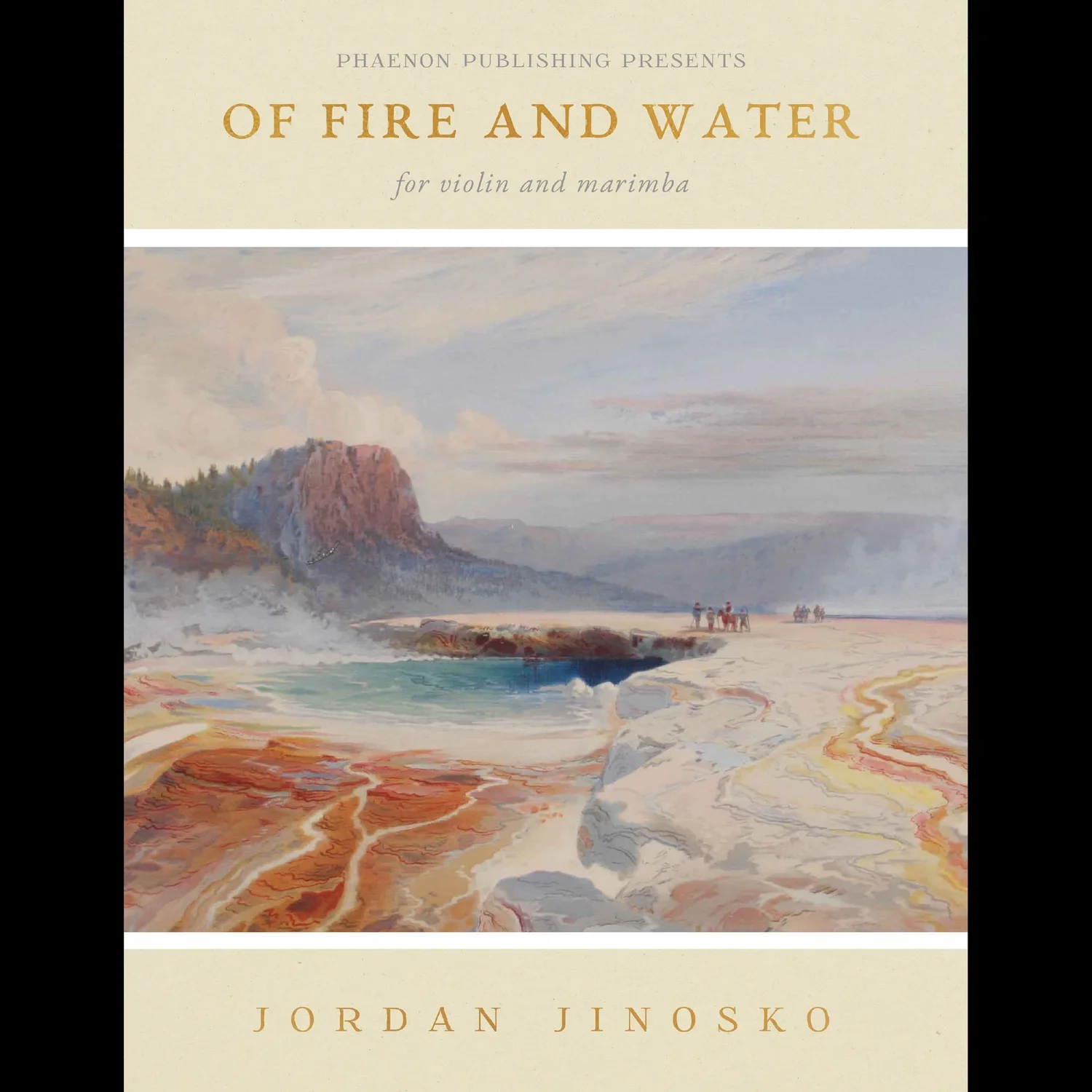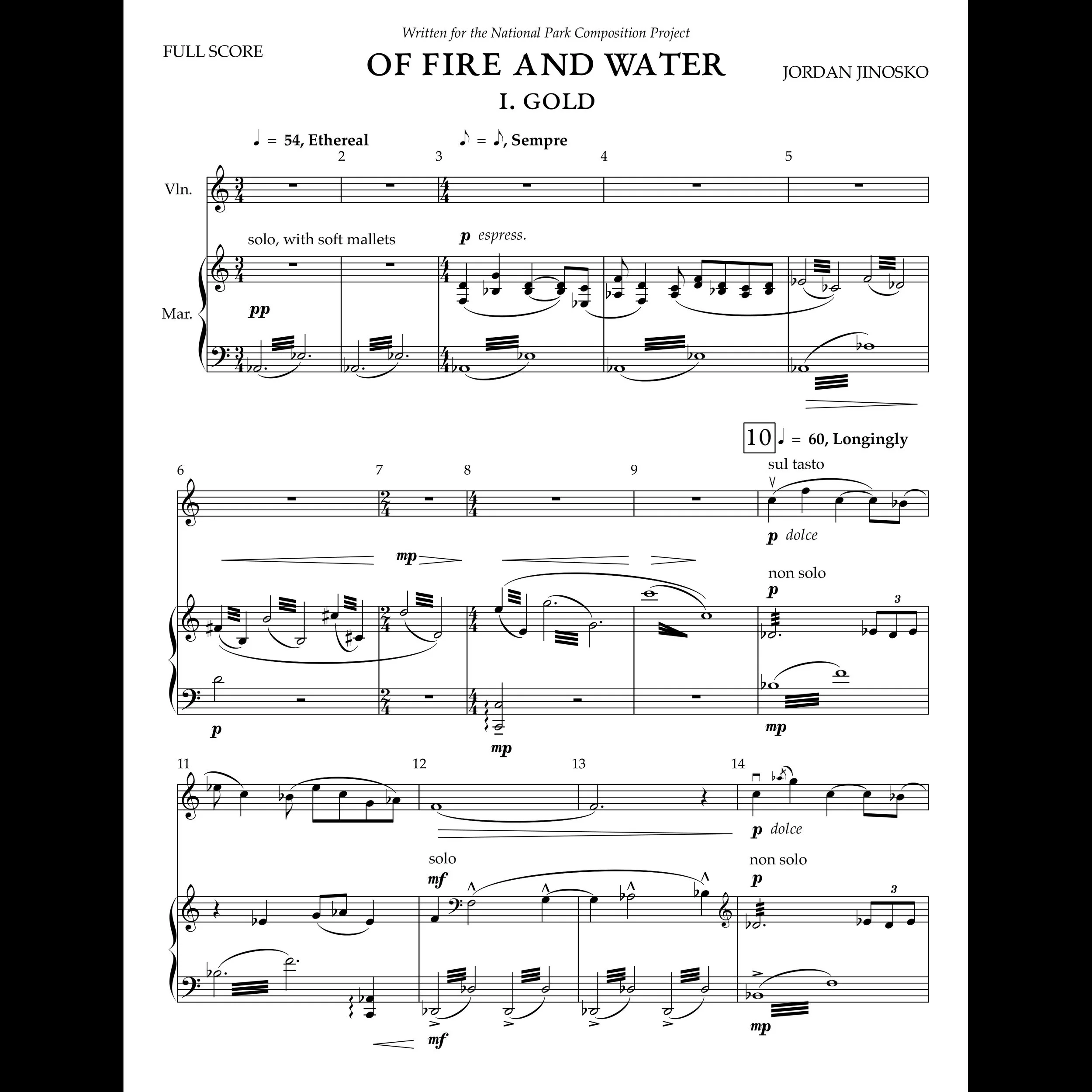 Image 1 of 4
Image 1 of 4

 Image 2 of 4
Image 2 of 4

 Image 3 of 4
Image 3 of 4

 Image 4 of 4
Image 4 of 4





Of Fire and Water for Violin and Marimba (Full Score and Violin Part) PDFs
Instrumentation: violin and marimba
Difficulty: Intermediate (Grade 4)
Duration: ca. 12 minutes
Program Note: I wrote Of Fire and Water as part of the National Park Composition Project in celebration of Yellowstone National Park, an area that has held a special place in my heart since I first visited as a child.
Drawing its title from the words of the environmentalist John Muir (who once described Yellowstone as “a strange region of fire and water”), this piece presents a series of vignettes that collectively comprise a brief history of the park.
”Gold” expresses the longing felt by settlers who arrived during the mid-1800s Gold Rush, marking the beginning of a new era of desperation. For these miners, who suffered extremely harsh conditions, gold provided hope for a better life. Musically, the shimmering sextuplet motif that moves through various chords evokes the glint of gold in a flowing river.
“Fire” celebrates the beautiful yet terrifying geothermal features of Yellowstone: geysers, thermal pools, and hot springs. This movement also contemplates the likely eruption of the Yellowstone Caldera, a supervolcano whose explosion would cause global famine, extinction, and the long-term cooling of the planet.
Drawing on the park’s long history of natural beauty, “Spirit” offers up a conclusive, lyrical, and folk-music-inspired tune. Its melody presents the timeless spirit of Yellowstone—the soul shared by its animals, natural wonders, and all the people who have explored the region since the Pleistocene.
I owe much to naturalists like painter Thomas Moran who, as a member of the Hayden Geological Survey expedition, created some of the most breathtaking depictions of the park, which continue to inspire people today. His work, alongside that of John Muir, drew attention to the need for national parks to preserve such extraordinary landscapes for future generations.
Document Sizes: The score and violin part are formatted for printing on A4 size paper, though these technically could be printed on any size paper. A popular substitution is Letter (8.5”x11”) size paper.
Instrumentation: violin and marimba
Difficulty: Intermediate (Grade 4)
Duration: ca. 12 minutes
Program Note: I wrote Of Fire and Water as part of the National Park Composition Project in celebration of Yellowstone National Park, an area that has held a special place in my heart since I first visited as a child.
Drawing its title from the words of the environmentalist John Muir (who once described Yellowstone as “a strange region of fire and water”), this piece presents a series of vignettes that collectively comprise a brief history of the park.
”Gold” expresses the longing felt by settlers who arrived during the mid-1800s Gold Rush, marking the beginning of a new era of desperation. For these miners, who suffered extremely harsh conditions, gold provided hope for a better life. Musically, the shimmering sextuplet motif that moves through various chords evokes the glint of gold in a flowing river.
“Fire” celebrates the beautiful yet terrifying geothermal features of Yellowstone: geysers, thermal pools, and hot springs. This movement also contemplates the likely eruption of the Yellowstone Caldera, a supervolcano whose explosion would cause global famine, extinction, and the long-term cooling of the planet.
Drawing on the park’s long history of natural beauty, “Spirit” offers up a conclusive, lyrical, and folk-music-inspired tune. Its melody presents the timeless spirit of Yellowstone—the soul shared by its animals, natural wonders, and all the people who have explored the region since the Pleistocene.
I owe much to naturalists like painter Thomas Moran who, as a member of the Hayden Geological Survey expedition, created some of the most breathtaking depictions of the park, which continue to inspire people today. His work, alongside that of John Muir, drew attention to the need for national parks to preserve such extraordinary landscapes for future generations.
Document Sizes: The score and violin part are formatted for printing on A4 size paper, though these technically could be printed on any size paper. A popular substitution is Letter (8.5”x11”) size paper.
